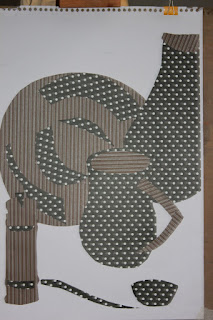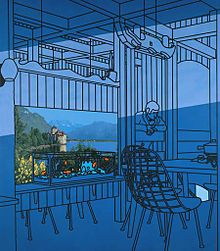New Media
Trying the different media was an interesting and informative experience,
I've always liked the effect of charcoal drawings and found that I enjoyed the marks this made and the way it blended. However, being an untidy kind of person means that I have too work quite carefully to avoid smudging.
Felt tip pens were not to my liking as much - I didn't like the way they bled into the paper but I did like the fine artist pens. I found these to be very even in the marks they made and can imagine they are good for hatching evenly. By contrast a bamboo pen dipped in ink create splodges and thicknesses of line that are not always controllable but I like the energy they give to a mark.
All in all this exercise shows how many materials are available and that thinking about what to use in terms of both mark makers and the type of paper needs to be considered when setting out on a piece of work. The combinations are so plentiful that at this early stage it would be sad to limit oneself to a few tried and trusted types.
Van Gogh
This artist liked trying different materials and experimenting with them but I can see why he liked using these bamboo pens.
(Van Gogh drawing and an attempt by me to copy it).
Reading about van Gogh's life and work shows how hard he worked to learn drawing. His personality conveys itself to me as a man driven to create art and to improve. His energy and commitment come through in these drawings and his work shows his originality in making marks to create what he wanted to show. He is an inspiration to someone learning to draw in the way he drew the same things over and over again. His marks included dots and dashes, curly squiggles as well as line that varied in its thickness. (Foe a particularly lovely and informative book about van Gogh's drawings see 'Van Gogh The Maste Draughtsman by Sjraar van Heugten).
Holding a pen or pencil near its tip enables small detail to be drawn whilst holding further along the shaft seems to create more freedom and energy. As above bamboo pen and ink seems to convey vitality but so does charcoal. Quick circular movements do the same.
Never having used pastels before I was a little frightened of them but tried them with interest on some coloured paste paper. They are very easy to blend but also very easy to overwork and so if a drawing is not going well it's difficult not to keep fiddling and deaden it. This is one of the difficult areas for me - when trying to convey something accurately I tend to overwork until it looks fussy. I'm hoping that this combination of looseness and accuracy will come with practice.
I found all the experiments interesting because it does show you how until you've tried something it's impossible to know if it will work for you. So for me the result is to keep trying new materials and combinations - certainly until I have a greater knowledge base and can make a more informed decision.
Supermarket Shop.
I tried pastel for this drawing and believe I created the correct proportions. I overlapped the objects to create a sense of depth and used tone to create a solid 3D look to everything. However I didn't know what to do with the background and ended up almost 'colouring it in'. All in all though I was quite pleased with the overall effect. This exercise was done after the books and jars exercise so I tried hard to get the perspective right and to work on the ellipses.
Jugs and Jars
Books
Initially, I thought that whilst the ellipses were difficult the books wouldn't create too much of a problem. How wrong can you be? A lot of people know that train lines converge when getting further away -basic one point perspective. And I had read Ian Simpson and looked at his sheets of card several time but still the penny didn't drop that here the problem is two lots of perspective. I could have done this again but have kept it to remind myself of the problem- with perspective and me!
Tone and Form
Tonal Studies
I didn't quite understand the instructions for this exercise but hope this version is correct.
I found it difficult to distinguish between the light sources but easier in the shadow areas. Also, I found that it varied depending on the local colour of the object and the material from which it was made. On the wood it was difficult to see as there was little reflection at all. Clearly an awareness of light is very important to depicting form but careful looking is essential.
When looking at light reflected from one object to another -
as in this drawing in pastel- initially I had drawn a stronger highlight on the pepper's side as I could see the light there. I had placed a white piece of card next to the pepper and it was only when I removed this to look again that I realised that this was a reflection from the card. As this light cannot be as strong as the main light source I reduced the intensity of the highlight and saw that it looked better immediately.
Reflected light and shade.
Charcoal and putty rubber
This drawing consists of two stainless saucepans and a glass pyrex bowl. I can see that the bowl looks rather weird (ellipses?) but the attempt at the light and shade was really useful as a way of making you look more carefully. I tried to show the light following the contours of the objects by blending them into different lavels of tone.
Depicting man made objects.
Suggesting three dimensions on man made objects, which can be a definite shape may mean they need to be accurately drawn. Here, I'm thinking of bottles which need symmetry both sides and ellipses. However, natural objects, whilst sometimes being more randon in shape may present different problems in depicting texture
Depicting solidity in composition requires several considerations. Depicting form with hatching or some other tonal technique; overlapping forms to suggest depth; ensuring shadows and light are well realised . I'm not sure that changing the arrangement of the composition makes a difference to the approach as the sense of form must still be depicted. However the fact that this question is being asked makes me think there must be a better answer than the one I've just given, so I'll try to remind myself of this and keep thinking.
Positioning oneself and the objects is intersting in that I saw a drawing of a man who had been shot and the artist had chosen to place the eye level way above the subject so that you got a sense of looking down on him- just as you would if he were lying on the ground and you are in a position of dominance. Similarly then placing the eye level lower must make a drawing more imposing and depends on the subject matter and the effect you want to achieve. When I placed the plate of fruit at eye level itself there was little shadow effect to see so form was difficult to observe.
In this instance I chose the position that I thought gave most opportunity for light and shade but keep the above point in mind as it's not a once and for all situation.
Frottage Techniques
Having read about Max Ernst and looked at some of the drawings he created using this technique I started the project on texture.
To start with I tried to get an impression of my oak floor but found that the paper was too thick so tried thinner sheets. Also, I found that a soft pencil was necessary to be successful, or graphite sticks, but read that charcoal powder works very well in some cases as it falls easily into all the grooves or impressions. I started again and tried wood and wicker. The wicker I found interesting as it was a chest and the long supports looked like elegant flowers as frottage. In fact they reminded me of delphiniums, one of my favourite flowers. However what intrigued me was how to incorporate frottage into a drawing. With thin paper not necessarily being first choice for a work. In the OCA work book on page 36 it looks as though Ernst has stuck the frottage on the paper, or is it the pear? Although in other works he has used several impressions to create a work with seemingly little other drawing (see La foret petrifiee).
I popped into our local DIY store too and grabbed some samples of wallpaper that had deep textures to them and played with these. I could see how some of these could be used in a work as background textures. I think too that frottage could be enlarged to gain a really close up sight of different textures which would be interesting to copy or to draw large.
One book I looked at suggested ways of incorporating frottage into an observational drawing without it looking as though a subject was sitting in the air rather than on the texture -eg this was eggs drawn on a plank type table top. The eggs were drawn first and then placed over the wood to ensure the composition worked. (see Eggs on a Table by Martin Davidson).
Objects with texture.
In my sketchbook I used an avocado stone -this had very little reflection and was quite flat. I tried coloured pencil and decided for my second attempt to keep the pencil layers lighter as light was still needed to come through the paper. Also tried the peel of the avocado as it is very dark with very deep channels. After I considered that it is probably easier to erase the highlights than keep trying to draw them. Carrying on with the fruit theme I attempted pineapple skin and banana skin. There are a few things I attempted that caused me problems; one is wicker as when I tried to observe it I felt that I kept losing my place. I know that drawing includes problem solving and I need to find ways to simplify these complicated textures. Hopefully, when I come to the unit on trees this will help me in this endeavour. The other problem was with a teddy bear. This particular bear has short, smooth fur so didn't give me any ideas on how to suggest his softness. Felt that his outline needed to be in a soft pencil and quite 'uneven' to suggest the fur. However, haven't got it right yet but will persevere.
Enlarging a simple image.
The grid itself was a problem - if it's not square it won't work. However as an exercise in enlarging an image I cannot see any problems with it. And copying the lines was not too difficult. Adjustments can be made if wanted as it's still your work. I read that Ingres often used grids for his drawings, placing a padded sheet over his final paper to protect it. When you look at some of his work you can see still the squares marked out.






























